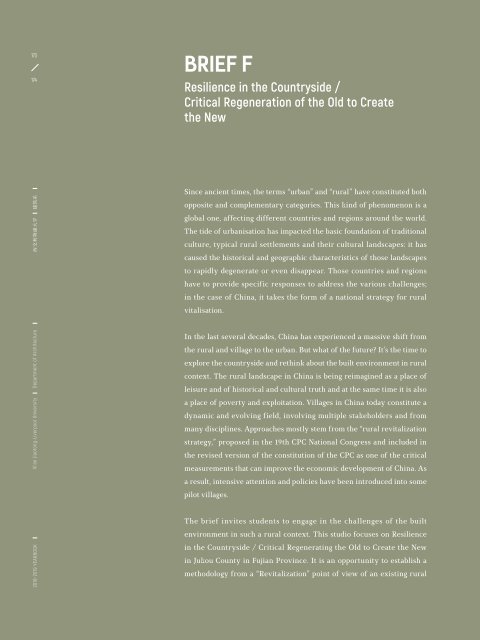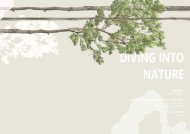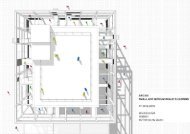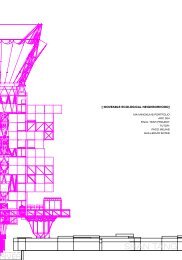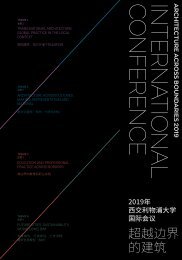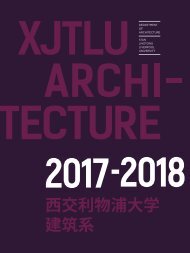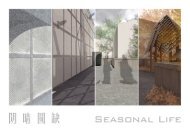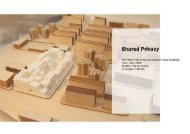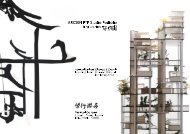YEARBOOK 2018 - 2019 | XJTLU DEPARTMENT OF ARCHITECTURE
The sixth edition of the yearbook of the Department of Architecture at Xi'an Jiaotong-Liverpool University presents student works created during the academic year 2018 - 2019. The yearbook exemplifies the new model for Chinese architectural education for which the department was commended by the Royal Institute of British Architects (RIBA). It is also a showcase of the creative culture that has guided our students towards successful international careers as responsible and creative architectural designers. The Department of Architecture at XJTLU offers RIBA Part 1, 2 and 3.
The sixth edition of the yearbook of the Department of Architecture at Xi'an Jiaotong-Liverpool University presents student works created during the academic year 2018 - 2019. The yearbook exemplifies the new model for Chinese architectural education for which the department was commended by the Royal Institute of British Architects (RIBA). It is also a showcase of the creative culture that has guided our students towards successful international careers as responsible and creative architectural designers. The Department of Architecture at XJTLU offers RIBA Part 1, 2 and 3.
You also want an ePaper? Increase the reach of your titles
YUMPU automatically turns print PDFs into web optimized ePapers that Google loves.
173<br />
174<br />
BRIEF F<br />
Resilience in the Countryside /<br />
Critical Regeneration of the Old to Create<br />
the New<br />
<strong>2018</strong>-<strong>2019</strong> <strong>YEARBOOK</strong> Xi’an Jiaotong-Liverpool University Department of Architecture 西 交 利 物 浦 大 学 建 筑 系<br />
Since ancient times, the terms “urban” and “rural” have constituted both<br />
opposite and complementary categories. This kind of phenomenon is a<br />
global one, affecting different countries and regions around the world.<br />
The tide of urbanisation has impacted the basic foundation of traditional<br />
culture, typical rural settlements and their cultural landscapes: it has<br />
caused the historical and geographic characteristics of those landscapes<br />
to rapidly degenerate or even disappear. Those countries and regions<br />
have to provide specific responses to address the various challenges;<br />
in the case of China, it takes the form of a national strategy for rural<br />
vitalisation.<br />
In the last several decades, China has experienced a massive shift from<br />
the rural and village to the urban. But what of the future? It’s the time to<br />
explore the countryside and rethink about the built environment in rural<br />
context. The rural landscape in China is being reimagined as a place of<br />
leisure and of historical and cultural truth and at the same time it is also<br />
a place of poverty and exploitation. Villages in China today constitute a<br />
dynamic and evolving field, involving multiple stakeholders and from<br />
many disciplines. Approaches mostly stem from the “rural revitalization<br />
strategy,” proposed in the 19th CPC National Congress and included in<br />
the revised version of the constitution of the CPC as one of the critical<br />
measurements that can improve the economic development of China. As<br />
a result, intensive attention and policies have been introduced into some<br />
pilot villages.<br />
The brief invites students to engage in the challenges of the built<br />
environment in such a rural context. This studio focuses on Resilience<br />
in the Countryside / Critical Regenerating the Old to Create the New<br />
in Jukou County in Fujian Province. It is an opportunity to establish a<br />
methodology from a “Revitalization” point of view of an existing rural<br />
village community and the studio invites students to explore, imagine<br />
and create new uses of buildings through research workshops and<br />
analysis. Students have collaborated to analyse existing rural villages<br />
through engagement with the village community and in Jukou County<br />
in Fujian Province which is a National ecological county. The site(s) are<br />
diversified and offer a rich cultural heritage and built environment.<br />
At the same time the students have built an understanding of the<br />
constraints and challenges surrounding the question of “Regenerating<br />
the Old to Create the New” through the envisioning of programmatic<br />
intervention, fabric and spatial organisation criticality, and with a view<br />
to a new usage and identification of end users, linked to the land and<br />
hence also the population.<br />
TEACHING TEAM<br />
Yiping Dong<br />
Richard Hay


